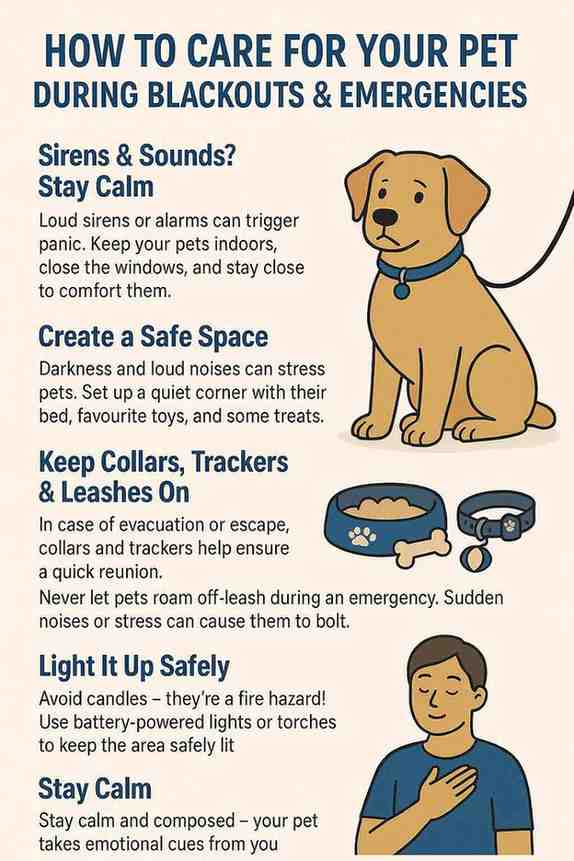
08 May
How to Keep Your Pet Safe in Blackouts and Emergencies
Emergencies can strike without warning. Fires, hurricanes, floods, earthquakes, and terrorism pose immediate threats to everyone in their path, for humans and animals alike. When planning for an emergency, it is crucial remember the pets of a household. Leaving pets behind can put them at serious risk of injury or loss, and endanger first responders. The key to protecting your pet is preparation.
Here's How to Keep Your Pet Safe During Emergencies

Start With a Plan
The first step to safeguarding your pet is to understand the risks in your region. Know the types of emergencies most likely to affect your area and prepare for them accordingly. Establish where you and your pet will go if you must evacuate. Many emergency shelters do not allow pets, so it is essential to locate pet-friendly accommodations ahead of time. This could include boarding facilities, veterinary clinics, animal shelters, or out-of-town friends and family.
Set up a buddy system with a trusted neighbour who can care for your animals if you are away from home. Identify veterinarians near your intended shelter location and include their contact information in your emergency kit.
Prepare Identification and Records
Make sure your pet always wears a collar with an ID tag that includes your current contact information. Microchipping your pet offers a permanent form of identification. Keep your microchip registration updated to improve the chances of reuniting if separated during an emergency.
Keep recent photos of your pet in your phone and emergency kit to help with identification if your pet gets lost. Mark all carriers with your pet’s name and your contact details.
Build a Pet Emergency Kit
Yes, it is impossible to predict when an emergency or catastrophe may arrive. However, you can prepare an emergency kit ahead of time to be prepared for any eventuality.
A complete emergency kit for your pet should include:
- Leash, harness, and carrier
- Food and water for at least 3 days
- Bowls, litter, and waste bags
- Medications and medical history
- Vaccination records, including rabies certificate
- First aid supplies
- Comfort items like toys or bedding
- A recent photo of your pet with you
Consult your veterinarian for help gathering your pet's medical documentation and prescriptions.
Practice Evacuation Beforehand
Train your pet to become comfortable with their carrier. Practice transporting them in a car, especially if they are not used to travelling inside a crate or in a vehicle. Learn about pattern of behaviour; for example, where your pet hides when stressed and practice how to retrieve them quickly and calmly.
If you do not have your own transportation, plan. Reach out to local emergency services or animal control to learn about evacuation assistance options. Have your entire household practice evacuation procedures with your pets to ensure everyone is prepared.
During an Emergency
Bring your pet with you if you evacuate. Never leave animals chained outdoors or confined in unsafe conditions, as this is dangerous for both the pet and the first responders on the scene. Always take your pet's emergency kit when you leave.
If you need shelter, reach out to:
- Local animal shelters or humane societies
- Veterinary clinics
- Friends or family outside the evacuation area
- Pet-friendly hotels along your route
After the Emergency
Returning home can be disorienting for pets. Scents and landmarks may have changed, which can cause confusion and distress. Always keep your pet on a leash or in a carrier when outdoors. Be cautious of hazards like exposed wires, sharp objects, or downed power lines.
Animals can behave differently under stress. Even well-behaved pets may act aggressively or unpredictably. Monitor their behaviour and contact a veterinarian if signs of stress or illness appear.
Keep pets away from wildlife and stray animals. Avoid stagnant or contaminated water sources, which may carry disease. Wash your hands after handling animals, their waste, or food, and avoid letting pets lick your face.
Post-emergency environments often increase the risk of disease. Fleas, ticks, and mosquitoes thrive in the aftermath of floods or storms and can transmit illnesses like Lyme disease. Maintain your pet’s regular preventive care and vaccinations. Speak to your veterinarian about ongoing protection against parasites.
If Your Pet Is Lost
First, make sure of your own safety. Once you are sure, contact local shelters, animal control, and your microchip provider. Share missing pet flyers and use photos from your emergency kit. Many animal welfare organizations operate recovery programs for pets displaced by emergencies.
Handling Injured Pets
Injured pets may react aggressively out of fear or pain. Avoid hugging them or putting your face near their mouth. Move slowly, speak softly, and stop if the animal becomes agitated. Seek veterinary care immediately while keeping your own safety in mind.
Be Ready Before It Matters
Emergencies may be unpredictable, but your response doesn’t have to be. With planning, training, and the right supplies, you can protect your pet’s safety and wellbeing no matter what comes. Make pet emergency preparedness a priority, for their sake and your own.






AUTHOR’S BIO
Carry My Pet
Passionate pet enthusiasts and globetrotters, dedicated to easing furry friends' journeys worldwide. Penning tales of compassion at CarryMyPet, where every relocation is a tail-wagging adventure.